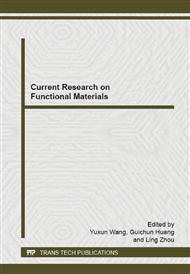[1]
Y. N. Huo, J. Zhang, M. Miao, Y. Jin, Solvothermal synthesis of flower-like BiOBr microspheres with highly visible-light photocatalytic performances, Appl. Catal. B 111-112 (2012) 334-341.
DOI: 10.1016/j.apcatb.2011.10.016
Google Scholar
[2]
Y. Park, S. H. Lee, S. O. Kang, W. Y. Choi, Organic dye-sensitized TiO2 for the redox conversion of water pollutants under visible light, Chem. Commun. 46 (2010) 2477-2479.
DOI: 10.1039/b924829c
Google Scholar
[3]
Z. Y. Liu, X. T. Zhang, S. Nisimoto, T. Murakami, A. Fujishima, Efficient photocatalytic degradation of gaseous acetaldehyde by highly ordered TiO2 nanotube arrays, Environ. Sci. Technol. 42 (2008) 8547-8551.
DOI: 10.1021/es8016842
Google Scholar
[4]
J. M. Wua, X. M. Song, M. Yan, Alkaline hydrothermal synthesis of homogeneous titania microspheres with urchin-like nanoarchitectures for dye effluent treatments, J. Hazard. Mater. 194 (2011) 338-344.
DOI: 10.1016/j.jhazmat.2011.07.110
Google Scholar
[5]
T. Fan, S. K. Chow, D. Zhang, Biomorphic mineralization: from biology to materials, Prog. Mater. Sci. 54 (2009) 542-659.
Google Scholar
[6]
M. W. Anderson, S. M. Holmes, N. Hanif, C. S. Cundy, Hierarchical pore structures through diatom zeolitization, Angew. Chem. Int. Ed. 39 (2000) 2707-2710.
DOI: 10.1002/1521-3773(20000804)39:15<2707::aid-anie2707>3.0.co;2-m
Google Scholar
[7]
Y. Kim, Small structures fabricated using ash-forming biological materials as templates, Biomacromolecules 4 (2003) 908-913.
DOI: 10.1021/bm0257558
Google Scholar
[8]
S. Zhu, D. Zhang, Z. Li, H. Furukawa, Z. Chen, Precision replication of hierarchical biological structures by metal oxides using a sonochemical method, Langmuir 24 (2008) 6292-6299.
DOI: 10.1021/la7037153
Google Scholar
[9]
D. Zhang, L. Qi, Synthesis of mesoporous titania networks consisting of anatase nanowires by templating of bacterial cellulose membranes, Chem. Commun. 21 (2005) 2735-2737.
DOI: 10.1039/b501933h
Google Scholar
[10]
H. Imai, M. Matsuta, K. Shimizu, H. Hirashima, N. Negishi, Preparation of TiO2 fibers with well-organized structures, J. Mater. Chem. 10 (2000) 2005-(2006).
DOI: 10.1039/b004543h
Google Scholar
[11]
S. Chia, J. Urano, F. Tamanoi, B. Dunn, J. I. Zink, Patterned Hexagonal Arrays of Living Cells in Sol-Gel Silica Films, J. Am. Chem. Soc. 122 (2000) 6488-6489.
DOI: 10.1021/ja0011515
Google Scholar
[12]
J. G. Huang, T. Kunitake, S. Onoue, A facile route to a highly stabilized hierarchical hybrid of titania nanotube and gold nanoparticle, Chem. Commun. 8 (2004) 1008-1009.
DOI: 10.1039/b401071j
Google Scholar
[13]
J. G. Huang, N. Matsunaga, K. Shimanoe, N. Yamazoe, T. Kunitake, Nanotubular SnO2 Templated by Cellulose Fibers: Synthesis and Gas Sensing, Chem. Mater. 17 (2005) 3513-3518.
DOI: 10.1021/cm047819m
Google Scholar
[14]
J. G. Huang, T. Kunitake, Nano-Precision Replication of Natural Cellulosic Substances by Metal Oxides, J. Am. Chem. Soc. 125 (2003) 1183411835.
DOI: 10.1021/ja037419k
Google Scholar
[15]
S. R. Hall, H. Bolger, S. Mann, Morphosynthesis of complex inorganic forms using pollen grain templates, Chem. Commun. 22 (2003) 2784-2785.
DOI: 10.1039/b309877j
Google Scholar
[16]
F. C. Meldrum, R. Seshadri, Porous gold structures through templating by echinoid skeletal plates, Chem. Commun. 1 (2000) 29-30.
DOI: 10.1039/a907074e
Google Scholar
[17]
T. Ota, M. Imaeda, H. Takase, M. Kobayashi, N. Kinoshita, T. Hirashita, H. Miyazaki, Y. Hikichi, Porous Titania Ceramic Prepared by Mimicking Silicified Wood, J. Am. Ceram. Soc. 83 (2000) 1521-1523.
DOI: 10.1111/j.1151-2916.2000.tb01421.x
Google Scholar
[18]
A. Zampieri, G. T. P. Mabande, T. Selvam, W. Schwieger, A. Rudolph, R. Hermann, H. Sieber, P. Greil, Biotemplating of Luffa cylindrica sponges to self-supporting hierarchical zeolite macrostructures for bio-inspired structured catalytic reactors, Mater. Sci. Engin: C 26 (2006).
DOI: 10.1016/j.msec.2005.08.036
Google Scholar
[19]
A. Shahbazi, H. Younesia, A. Badiei, Functionalized SBA-15 mesoporous silica by melamine-based dendrimer amines for adsorptive characteristics of Pb(II), Cu(II) and Cd(II) heavy metal ions in batch and fixed bed column, Chem. Engin. J. 168 (2011).
DOI: 10.1016/j.cej.2010.11.053
Google Scholar
[20]
Y. Jiang, Q. Gao, H. Yu, Y. Chen, F. Deng, Intensively competitive adsorption for heavy metal ions by PAMAM–SBA-15 and EDTA–PAMAM–SBA-15 inorganic-organic hybrid materials, Microporous Mesoporous Mater. 103 (2007) 316-324.
DOI: 10.1016/j.micromeso.2007.02.024
Google Scholar
[21]
C. Anderson, A. J. Bard, An Improved Photocatalyst of TiO2/SiO2 Prepared by a Sol-Gel Synthesis, J. Phys. Chem. 99 (1995) 9882-9885.
DOI: 10.1021/j100024a033
Google Scholar
[22]
Y. C. Miao, Z. B. Zhai, J. He, B. Li, J. J. Li, J. Q. Wang, Synthesis, characterizations and photocatalytic studies of mesoporous titania prepared by using four plant skins as templates, Mater. Sci. Engin. C 30 (2010) 839-846.
DOI: 10.1016/j.msec.2010.03.020
Google Scholar
[23]
G. Socrates, Infrared and Raman Characteristic Group Frequencies: tables and charts, 3rd ed., John Wiley & Sons, Ltd, (2004).
DOI: 10.1002/jrs.1238
Google Scholar
[24]
D. A. Palmer , R. V. Eldik, The chemistry of metal carbonato and carbon dioxide complexes, Chem. Rev. 83 (1983) 651-731.
DOI: 10.1021/cr00058a004
Google Scholar
[25]
S. J. Yu, H. J. Yun, Y. H. Kim, J. Yi, Carbon-doped TiO2 nanoparticles wrapped with nanographene as a high performance photocatalyst for phenol degradation under visible light irradiation, Appl. Catal. B, 144 (2014) 893-899.
DOI: 10.1016/j.apcatb.2013.08.030
Google Scholar
[26]
R. Q. Cabrera, A. Mills, C. O'Rourke, Action spectra of P25 TiO2 and a visible light absorbing, carbon-modified titania in the photocatalytic degradation of stearic acid, Appl. Catal. B 150-151 (2014) 5) 338-344.
DOI: 10.1016/j.apcatb.2013.12.008
Google Scholar


